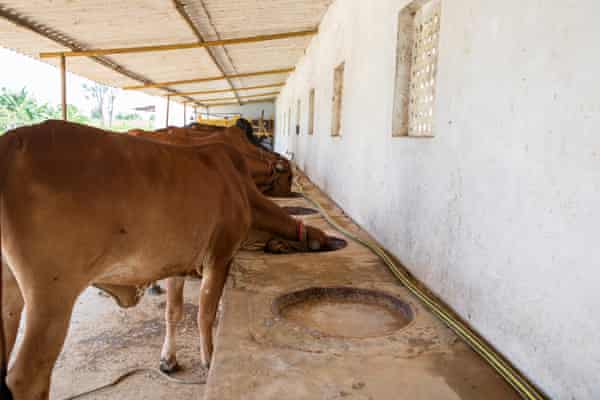KAilas Ramasamy gently guides his cows into a hangar-sized shed, tethers them to their posts, lays out their fodder and cleans the floor. Then, as he steps out, he flips a switch: ceiling fans begin to blow air on the cattle.
Ramasamy’s dairy farm is an hour outside southern India’s Bengaluru city. Usually known for its moderate weather, the region has witnessed a sharp rise in temperature compared with earlier decades. Elsewhere in India, temperatures have reached 50C (122F) this year.
That is bad news for India’s dairy industry, with heat stress leading to reduced appetite, lower weight gain and decreased fertility in cattle. Rising temperatures could reduce milk output by up to 25% in India’s hotter areas by 2085, according to recent research published in the Lancet.
Heat stress is a global problem, with thousands of cattle reported to have died Last week in the US state of Kansas as temperatures of more than 37C were compounded by high levels of humidity.
But for India, any significant decline in milk production could be devastating for food security if it ends self-sufficiency in dairy in the world’s second most populous country.
The consequences would also be devastating for 80 million Indians employed across the dairy industry.
These are problems that Ranganatha Reddy knows well. Temperatures on his dairy farm in Anantapur, 120 miles (200km) from Bengaluru, hit 43C in May.
“My cows usually have an internal alarm clock and start mooing when it’s meal time because they’re always hungry,” he says. “But during the heatwave I had to almost force-feed them.”
His farm’s milk output dropped by 30% month-on-month. “It felt like I was wringing a dry sponge.”
While climate change is a global phenomenon, the large number of small dairy holdings in India and a growing dependence on breeds that are vulnerable to heat stress could affect the country more than other big dairy producers such as the US or Brazil.
In the 1970s, India began crossbreeding imported, high-yield varieties of cattle with local species, helping turn the country from running a dairy deficit to producing 22% of the world’s milk.
India’s most recent livestock census found that the population of crossbred cattle had increased by 26% since 2012, while indigenous varieties decreased by 6%.
It makes financial sense to switch to crossbred cows as they produce “much more milk”, says Ramendra Das, a veterinary scientist who has studied the impact of warming temperatures on different breeds – but they are more vulnerable to heat stress than indigenous varieties.

Ramasamy, who buys and sells milk from local farmers through the company Vrindavan Dairy, is trying to promote the use of indigenous cows by paying more for milk from Indian cows (42p a litre) than from crossbreeds (32p).
Solutions to ward off heat stress include specially designed sheds with fans and sprinklers to keep cattle cool, but that comes at a high cost. “Only big, intensive dairy farms can afford such infrastructure,” says Girdhari Ramdas Patil, a former joint director at the National Dairy Research Institute. Almost two-thirds of India’s milk is produced by small-scale farmers.

Philip Thornton, a scientist at the Consortium of International Agricultural Research Centers and lead author of the Lancet study on heat stress milk yield losses, says that crossbreeding climate-resilient cattle varieties and higher-yielding cows might help in the long run.
For Ramasamy, the answer has been to seek better indigenous breeds. He has started breeding Gyr cows from northern India that give more milk than other breeds while also consuming less food and water than crossbred varieties.
Does he think the lower maintenance costs and risks of heat stress will persuade more farmers to turn to Indian breeds? “It’s going to be difficult, but I’m convinced that is the future,” he says.
Sign up for the Animals Farmed monthly update to get a roundup of the biggest farming and food stories across the world and keep up with our investigations. You can send us your stories and thoughts at [email protected]
www.theguardian.com
George is Digismak’s reported cum editor with 13 years of experience in Journalism